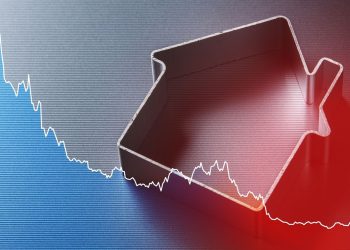Through the early months of this year, Fed Chair Jerome Powell, Treasury Secretary Janet Yellen and a broad swath of economists insisted that inflation had plateaued—or soon would—offering hope that a steady increase in interest rates this year could guide the overheating economy through a so-called “soft landing” and avoid recession.
But last month’s inflation data was enough to convince Powell and the Fed that a planned series of 50 basis-point rate hikes through the summer is too little, too slow, as the central bank announced today a 75-basis-point hike, something that was both widely expected after the inflation report, but also a significant hawkish shift after months of downplaying the threat.
In a press conference following the announcement, Powell acknowledged that the new inflation data had altered what the Fed wanted, and left open the possibility of a 75-point increase after the central bank’s next meeting.
“Our policy has been adapting and it will continue to do so,” Powell said. “In the coming months, we will be looking for compelling evidence that inflation is moving down, consistent with inflation returning to 2%. We anticipate that ongoing rate increases will be appropriate. The pace of those changes will continue to depend on the incoming data and the evolving outlook for the economy. Clearly today’s 75-point increase is an unusually large one, and I do not expect moves of this kind to be common.”
After Powell said that the Fed was not “actively considering” a 75-basis-point hike last May, the choice to increase the pace of rate hikes on short notice serves as some of the strongest evidence that the central bank will move more decisively to end inflation going forward, which many worry might send the economy into recession.
Despite all this, Powell explicitly said at the press conference that either a 50- or 75-point increase “seems most likely at our next meeting,” while again reiterating that all decisions would be made accounting for new data.
After somewhat walking back the position that inflation was “transitory” earlier this year, Powell has taken a more judicious stance, admitting that “inflation is likely to take longer to return to our price stability goal than previously expected” in March, and in May promising that the central bank would implement “restrictive” policy if that was the only way to curb inflation.
Some economists posited that markets have already been pricing in the larger hike, with mortgage rates, in particular, spiking dramatically following the inflation report, reaching an average of more than 6.5% this week.
Mortgage Banker Association (MBA) Associate Vice President of Economic and Industry Forecasting Joel Kan directly connected the mortgage rate increase to the anticipated Fed hike, saying markets’ “anticipation that the Federal Reserve will need to raise rates at a faster pace” is driving that metric.
National Association of REALTORS® (NAR) Chief Economist Lawrence Yun pointed out mortgage rates have increased at roughly double the federal fund rate.
“On the same $300,000 mortgage, the monthly payment has risen from $1265 in December to $1800 today. That’s painful and, consequently, will shrink the buyer pool,” Yun said. “Sales could fall even further with some inventory sitting on the market for more than a month like in the pre-pandemic days. Pricing a listed home properly will, therefore, be the key to attracting buyers…only when consumer price inflation tops out and starts to fall will mortgage rates stabilize or even decline a bit.”
Ruben Gonzales, chief economist for Keller Williams, said in a statement that this will continue to be the case as the Fed potentially looks at more and larger rate increases.
“Mortgage rates going forward will continue to be responsive to changes in expectations around the Fed’s policy path, as well as inflation expectations,” he said.
MBA Chief Economist Mike Fratantoni said in a statement that the move and goals of the Fed looked to be effective in achieving their goals as far as inflation, at least.
“The Federal Reserve is racing to catch up to economic events, announcing today a 75-basis-point increase and signaling more increases to come,” he said. “A federal funds target rate likely to reach almost 4 percent by the end of 2023 should be effective in slowing the economy and ultimately bringing down inflation.”
Fratantoni added that mortgage rates in the short term might still be a weight on the housing market, though not an unshakable one.
“The housing market has slowed considerably over the past month as rate increases have taken hold. We expect that this slower pace will remain through the summer, but buyers could return later this year if the Fed’s plans are better understood by the market and lead to less rate volatility,” he predicted.
The exact path the Fed will take going forward is possibly more difficult to predict now than it was a month, or even a week ago, as Powell faced questions about whether he had lost some public confidence by shifting course after long predicting a 50 basis point hike. He called the timing of the inflation data “very unusual,” while defending the Fed’s credibility.
“I would like to think, though, that our guidance is still credible, but it’s always going to be conditional on what happens,” he said.
Multiple times throughout the closely-watched press conference. Powell explicitly laid out the Fed’s “overarching message,” focused on bringing inflation down.
“We at the Fed understand the hardship that high inflation is causing. We’re strongly committed to bringing inflation back down, and moving expeditiously to do so,” he said.
When asked directly whether another hot inflation report would necessarily result in another 75 basis point hike, or possibly something even higher, Powell remained noncommittal.
“We’re going to react to the incoming data, and appropriately, I think,” he said.
As far as the possibility of avoiding a recession while still meeting the targets of 2% inflation and a health job market, Powell expressed confidence that a “soft landing” was still possible.
“Do I still think we can do that? I do,” he said. “That is our objective, and I do think its possible. Like I said, though, I think the events of the last few months have raised the degree of difficulty, created great challenges. …there’s a much bigger chance now that it will depend on factors that we can’t control. ”
Editor’s note: this story was updated with comments from Lawrence Yun, Mike Fratantoni and additional comments from Fed chair Jerome Powell.

Jesse Williams is RISMedia’s associate online editor. Email him your real estate news to jwilliams@rismedia.com.












